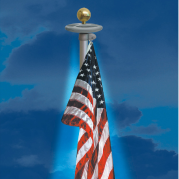Annin Historical Flags
(40)Annin Historical Flags
(40)-
British Red Ensign 3ft x 5ft Printed Polyester
Regular price $7.95Regular price20% off Unit price / per$9.99Sale price $7.95Sale -
Green Mountain Boys 3ft x 5ft Nylon flag
Regular price $48.64Regular priceUnit price / per$0.00Sale price $48.64 -
Colonial Series Desk No.2 Display
Regular price $17.99Regular priceUnit price / per$0.00Sale price $17.99 -
Flags of Our Country Desk Display
Regular price $36.99Regular priceUnit price / per$0.00Sale price $36.99 -
French Fleur de lis 3ft x 5ft Nylon Flag
Regular price $57.99Regular priceUnit price / per$0.00Sale price $57.99 -
Confederate Rebel Flag 3ft x 5ft Printed Polyester
Regular price $8.99Regular priceUnit price / per$0.00Sale price $8.99Sold out -
Confederate 1st National 3ft x 5ft Printed Polyester Flag
Regular price $6.99Regular priceUnit price / per$0.00Sale price $6.99Sold out -
Continental 3ft x 5ft Printed Polyester
Regular price $8.95Regular price5% off Unit price / per$9.50Sale price $8.95Sold out -
The Bedford 3ft x 3ft Nylon Flag
Regular price $57.99Regular priceUnit price / per$0.00Sale price $57.99Sold out -
Philadelphia Light Horse 3ft x 5ft Nylon Flag
Regular price $57.99Regular priceUnit price / per$0.00Sale price $57.99Sold out -
The Union Civil War 3ft x 5ft Super Knit Polyester flag
Regular price $11.95Regular priceUnit price / per$0.00Sale price $11.95Sold out -
Grand Union or Continental flag 4 x 6 inch
Regular price $1.58Regular priceUnit price / per$0.00Sale price $1.58Sold out -
Grand Union 3ft x 5ft Nylon flag
Regular price $51.52Regular priceUnit price / per$0.00Sale price $51.52Sold out -
"Come and Take It" Printed Polyester 3' x 5' Flag - Gonzales Flag
Regular price $2.05Regular price65% off Unit price / per$5.99Sale price $2.05Sold out -
Union Civil War-35 Star 3ft x 5ft Nylon Flag
Regular price $141.67Regular priceUnit price / per$0.00Sale price $141.67Sold out -
3ft x 5ft Cavalry Guidon Flag - Outdoor Nylon
Regular price $48.64Regular priceUnit price / per$0.00Sale price $48.64Sold out -
Continental 3ft x 5ft Super Knit Polyester flag
Regular price $11.95Regular priceUnit price / per$0.00Sale price $11.95Sold out -
Confederate Flag Desk Set
Regular price $11.55Regular price15% off Unit price / per$13.69Sale price $11.55Sold out









































